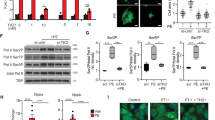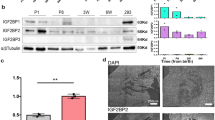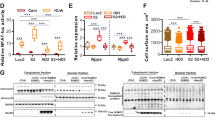Abstract
Programmed cardiac myocyte death contributes to pathological ventricular remodeling and the progression of myocardial infarction or pressure overload hypertrophy to dilated cardiomyopathy. Recent work has identified importance of stress-mediated transcriptional induction of BNIP3 (BCL2 and 19-kDa interacting protein-3) and NIX/BNIP3L in cardiac remodeling. Here, the regulatory mechanisms for these two factors in the heart and their effects on programmed cardiomyocyte death are reviewed, with a focus on information derived from studies using mouse models of cardiac BNIP3 and NIX/BNIP3L overexpression and gene ablation.
This is a preview of subscription content, access via your institution
Access options
Subscribe to this journal
Receive 50 print issues and online access
$259.00 per year
only $5.18 per issue
Buy this article
- Purchase on Springer Link
- Instant access to full article PDF
Prices may be subject to local taxes which are calculated during checkout


Similar content being viewed by others
References
Antman EM, Hand M, Armstrong PW, Bates ER, Green LA, Halasyamani LK et al. (2008). 2007 focused update of the ACC/AHA 2004 guidelines for the management of patients with ST-elevation myocardial infarction. Circulation 117: 296–329.
Ashkenazi A, Dixit VM . (1999). Apoptosis control by death and decoy receptors. Curr Opin Cell Biol 11: 255–260.
Baetz D, Regula KM, Ens K, Shaw J, Kothari S, Yurkova N et al. (2005). Nuclear factor-kappaB-mediated cell survival involves transcriptional silencing of the mitochondrial death gene BNIP3 in ventricular myocytes. Circulation 112: 3777–3785.
Berry JJ, Hoffman JM, Steenbergen C, Baker JA, Floyd C, Van Trigt P et al. (1993). Human pathologic correlation with PET in ischemic and nonischemic cardiomyopathy. J Nucl Med 34: 39–47.
Birse-Archbold JL, Kerr LE, Jones PA, McCulloch J, Sharkey J . (2005). Differential profile of Nix upregulation and translocation during hypoxia/ischaemia in vivo versus in vitro. J Cereb Blood Flow Metab 25: 1356–1365.
Bolli R, Marban E . (1999). Molecular and cellular mechanisms of myocardial stunning. Physiol Rev 79: 609–634.
Bouillet P, Metcalf D, Huang DC, Tarlinton DM, Kay TW, Kontgen F et al. (1999). Proapoptotic Bcl-2 relative Bim required for certain apoptotic responses, leukocyte homeostasis, and to preclude autoimmunity. Science 286: 1735–1738.
Bruick RK . (2000). Expression of the gene encoding the proapoptotic Nip3 protein is induced by hypoxia. Proc Natl Acad Sci USA 97: 9082–9087.
Burton TR, Henson ES, Baijal P, Eisenstat DD, Gibson SB . (2005). The pro-cell death Bcl-2 family member, BNIP3, is localized to the nucleus of human glial cells: implications for glioblastoma multiforme tumor cell survival under hypoxia. Int J Cancer 118: 1660–1669.
Chen G, Cizeau J, Vande VC, Park JH, Bozek G, Bolton J et al. (1999). Nix and Nip3 form a subfamily of pro-apoptotic mitochondrial proteins. J Biol Chem 274: 7–10.
Chen G, Ray R, Dubik D, Shi L, Cizeau J, Bleackley RC et al. (1997). The E1B 19K/Bcl-2-binding protein Nip3 is a dimeric mitochondrial protein that activates apoptosis. J Exp Med 186: 1975–1983.
Chen Z, Chua CC, Ho YS, Hamdy RC, Chua BH . (2001). Overexpression of Bcl-2 attenuates apoptosis and protects against myocardial I/R injury in transgenic mice. Am J Physiol Heart Circ Physiol 280: H2313–H2320.
Cizeau J, Ray R, Chen G, Gietz RD, Greenberg AH . (2000). The C. elegans orthologue ceBNIP3 interacts with CED-9 and CED-3 but kills through a BH3- and caspase-independent mechanism. Oncogene 19: 5453–5463.
Condorelli G, Morisco C, Stassi G, Notte A, Farina F, Sgaramella G et al. (1999). Increased cardiomyocyte apoptosis and changes in proapoptotic and antiapoptotic genes bax and bcl-2 during left ventricular adaptations to chronic pressure overload in the rat. Circulation 99: 3071–3078.
Cregan SP, Dawson VL, Slack RS . (2004). Role of AIF in caspase-dependent and caspase-independent cell death. Oncogene 23: 2785–2796.
Danial NN, Korsmeyer SJ . (2004). Cell death: critical control points. Cell 116: 205–219.
Di Napoli P, Taccardi AA, Grilli A, Felaco M, Balbone A, Angelucci D et al. (2003). Left ventricular wall stress as a direct correlate of cardiomyocyte apoptosis in patients with severe dilated cardiomyopathy. Am Heart J 146: 1105–1111.
Diwan A, Dorn GW . (2007). Decompensation of cardiac hypertrophy: cellular mechanisms and novel therapeutic targets. Physiology (Bethesda) 22: 56–64.
Diwan A, Koesters AG, Odley AM, Pushkaran S, Baines CP, Spike BT et al. (2007a). Unrestrained erythroblast development in Nix−/− mice reveals a mechanism for apoptotic modulation of erythropoiesis. Proc Natl Acad Sci USA 104: 6794–6799.
Diwan A, Krenz M, Syed FM, Wansapura J, Ren X, Koesters AG et al. (2007b). Inhibition of ischemic cardiomyocyte apoptosis through targeted ablation of Bnip3 restrains postinfarction remodeling in mice. J Clin Invest 117: 2825–2833.
Diwan A, Matkovich SJ, Yuan Q, Zhao W, Yatani A, Heller-Brown J et al. (2008a). Endoplasmic reticular–mitochondrial crosstalk in Nix-mediated cell death. J Clin Invest 118: 3870–3880.
Diwan A, Wansapura J, Syed FM, Matkovich SJ, Lorenz JN, Dorn GW . (2008b). Nix-mediated apoptosis links myocardial fibrosis, cardiac remodeling, and hypertrophy decompensation. Circulation 117: 396–404.
Dorn II GW . (2005). Physiologic growth and pathologic genes in cardiac development and cardiomyopathy. Trends Cardiovasc Med 15: 185–189.
Dorn II GW . (2009). Apoptotic and non-apoptotic programmed cardiomyocyte death in ventricular remodelling. Cardiovasc Res 81: 465–473.
Foo RS, Chan LK, Kitsis RN, Bennett MR . (2007). Ubiquitination and degradation of the anti-apoptotic protein ARC by MDM2. J Biol Chem 282: 5529–5535.
Foo RS, Mani K, Kitsis RN . (2005). Death begets failure in the heart. J Clin Invest 115: 565–571.
Foyouzi-Youssefi R, Arnaudeau S, Borner C, Kelley WL, Tschopp J, Lew DP et al. (2000). Bcl-2 decreases the free Ca2+ concentration within the endoplasmic reticulum. Proc Natl Acad Sci USA 97: 5723–5728.
Francis GS . (1998). Changing the remodeling process in heart failure: basic mechanisms and laboratory results. Curr Opin Cardiol 13: 156–161.
Frazier DP, Wilson A, Graham RM, Thompson JW, Bishopric NH, Webster KA . (2006). Acidosis regulates the stability, hydrophobicity, and activity of the BH3-only protein Bnip3. Antioxid Redox Signal 8: 1625–1634.
Galvez AS, Brunskill EW, Marreez Y, Benner BJ, Regula KM, Kirschenbaum LA et al. (2006). Distinct pathways regulate proapoptotic Nix and BNip3 in cardiac stress. J Biol Chem 281: 1442–1448.
Graham RM, Thompson JW, Wei J, Bishopric NH, Webster KA . (2007). Regulation of Bnip3 death pathways by calcium, phosphorylation, and hypoxia-reoxygenation. Antioxid Redox Signal 9: 1309–1315.
Grossman W, Jones D, McLaurin LP . (1975). Wall stress and patterns of hypertrophy in the human left ventricle. J Clin Invest 56: 56–64.
Hamacher-Brady A, Brady NR, Gottlieb RA, Gustafsson AB . (2006). Autophagy as a protective response to Bnip3-mediated apoptotic signaling in the heart. Autophagy 2: 307–309.
Hamacher-Brady A, Brady NR, Logue SE, Sayen MR, Jinno M, Kirshenbaum LA et al. (2007). Response to myocardial ischemia/reperfusion injury involves Bnip3 and autophagy. Cell Death Differ 14: 146–157.
Haworth RA, Hunter DR . (1979). The Ca2+-induced membrane transition in mitochondria. II. Nature of the Ca2+ trigger site. Arch Biochem Biophys 195: 460–467.
Hayakawa Y, Chandra M, Miao W, Shirani J, Brown JH, Dorn GW et al. (2003). Inhibition of cardiac myocyte apoptosis improves cardiac function and abolishes mortality in the peripartum cardiomyopathy of Galpha(q) transgenic mice. Circulation 108: 3036–3041.
Henriquez M, Armisen R, Stutzin A, Quest AFG . (2008). Cell death by necrosis, a regulated way to go. Curr Mol Med 8: 187–206.
Hunt SA, Abraham WT, Chin MH, Feldman AM, Francis GS, Ganiats TG et al. (2005). ACC/AHA 2005 Guideline Update for the Diagnosis and Management of Chronic Heart Failure in the Adult: a report of the American College of Cardiology/American Heart Association Task Force on Practice Guidelines (Writing Committee to Update the 2001 Guidelines for the Evaluation and Management of Heart Failure): developed in collaboration with the American College of Chest Physicians and the International Society for Heart and Lung Transplantation: endorsed by the Heart Rhythm Society. Circulation 112: e154–e235.
Kothari S, Cizeau J, McMillian-Ward E, Israels SJ, Bailes M, Ens K et al. (2003). BNIP3 plays a role in hypoxic cell death in human epithelial cells that is inhibited by growth factors EGF and IGF. Oncogene 22: 4734–4744.
Kroemer G, Levine B . (2008). Autophagic cell death: the story of a misnomer. Nat Rev Mol Cell Biol 9: 1004–1010.
Kubasiak LA, Hernandez OM, Bishopric NH, Webster KA . (2002). Hypoxia and acidosis activate cardiac myocyte death through the Bcl-2 family protein BNIP3. Proc Natl Acad Sci USA 99: 12825–12830.
Kubli DA, Quinsay MN, Huang C, Lee Y, Gustafsson AB . (2008). Bnip3 functions as a mitochondrial sensor of oxidative stress during myocardial ischemia and reperfusion. Am J Physiol Heart Circ Physiol 295: H2025–H2031.
Latif N, Khan MA, Birks E, O’Farrell A, Westbrook J, Dunn MJ et al. (2000). Upregulation of the Bcl-2 family of proteins in end stage heart failure. J Am Coll Cardiol 35: 1769–1777.
Leist M, Single B, Castoldi AF, Kühnle S, Nicotera P . (1997). Intracellular adenosine triphosphate (ATP) concentration: a switch in the decision between apoptosis and necrosis. J Exp Med 185: 1481–1486.
Lemasters JJ, Nieminen AL, Qian T, Trost LC, Elmore SP, Nishimura Y et al. (1998). The mitochondrial permeability transition in cell death: a common mechanism in necrosis, apoptosis, and autophagy. Biochim Biophys Acta 1366: 177–196.
Li Y, Wang Y, Kim E, Beemiller P, Wang CY, Swanson J et al. (2007). Bnip3 mediates the hypoxia-induced inhibition on mammalian target of rapamycin by interacting with Rheb. J Biol Chem 282: 35803–35813.
MacEwan DJ . (2002). TNF ligands and receptors—a matter of life and death. Br J Pharmacol 135: 855–875.
Nakayama H, Chen X, Baines CP, Klevitsky R, Zhang X, Zhang H et al. (2007). Ca2+- and mitochondrial-dependent cardiomyocyte necrosis as a primary mediator of heart failure. J Clin Invest 117: 2431–2444.
Nam Y-J, Mani K, Ashton AW, Peng C-F, Krishnamurthy B, Hayakawa Y et al. (2004). Inhibition of both the extrinsic and intrinsic death pathways through nonhomotypic death-fold interactions. Mol Cell 15: 912.
Narula J, Arbustini E, Chandrashekhar Y, Schwaiger M . (2001). Apoptosis and the systolic dysfunction in congestive heart failure. Story of apoptosis interruptus and zombie myocytes. Cardiol Clin 19: 113–126.
Narula J, Haider N, Virmani R, DiSalvo TG, Kolodgie FD, Hajjar RJ et al. (1996). Apoptosis in myocytes in end-stage heart failure. N Engl J Med 335: 1182–1189.
Nutt LK, Pataer A, Pahler J, Fang B, Roth J, McConkey DJ et al. (2002). Bax and Bak promote apoptosis by modulating endoplasmic reticular and mitochondrial Ca2+ stores. J Biol Chem 277: 9219–9225.
Olivetti G, Abbi R, Quaini F, Kajstura J, Cheng W, Nitahara JA et al. (1997). Apoptosis in the failing human heart. N Engl J Med 336: 1131–1141.
Olivetti G, Capasso JM, Sonnenblick EH, Anversa P . (1990). Side-to-side slippage of myocytes participates in ventricular wall remodeling acutely after myocardial infarction in rats. Circ Res 67: 23–34.
Oltersdorf T, Elmore SW, Shoemaker AR, Armstrong RC, Auger DJ, Belli BA et al. (2005). An inhibitor of Bcl-2 family proteins induces regression of solid tumours. Nature 435: 677–681.
Ranger AM, Zha J, Harada H, Datta SR, Danial NN, Gilmore AP et al. (2003). Bad-deficient mice develop diffuse large B cell lymphoma. Proc Natl Acad Sci USA 100: 9324–9329.
Ray R, Chen G, Vande VC, Cizeau J, Park JH, Reed JC et al. (2000). BNIP3 heterodimerizes with Bcl-2/Bcl-X(L) and induces cell death independent of a Bcl-2 homology 3 (BH3) domain at both mitochondrial and nonmitochondrial sites. J Biol Chem 275: 1439–1448.
Regula KM, Ens K, Kirshenbaum LA . (2002). Inducible expression of BNIP3 provokes mitochondrial defects and hypoxia-mediated cell death of ventricular myocytes. Circ Res 91: 226–231.
Rizzuto R, Pozzan T . (2006). Microdomains of intracellular Ca2+: molecular determinants and functional consequences. Physiol Rev 86: 369–408.
Rubart M, Field LJ . (2006). Cardiac regeneration: repopulating the heart. Annu Rev Physiol 68: 29–49.
Saelens X, Festjens N, Vande WL, van Gurp M, van Loo G, Vandenabeele P . (2004). Toxic proteins released from mitochondria in cell death. Oncogene 23: 2861–2874.
Sandoval H, Thiagarajan P, Dasgupta SK, Schumacher A, Prchal JT, Chen M et al. (2008). Essential role for Nix in autophagic maturation of erythroid cells. Nature 454: 232–235.
Schmidt-Kastner R, Aguirre-Chen C, Kietzmann T, Saul I, Busto R, Ginsberg MD . (2004). Nuclear localization of the hypoxia-regulated pro-apoptotic protein BNIP3 after global brain ischemia in the rat hippocampus. Brain Res 1001: 133–142.
Schweers RL, Zhang J, Randall MS, Loyd MR, Li W, Dorsey FC et al. (2007). NIX is required for programmed mitochondrial clearance during reticulocyte maturation. Proc Natl Acad Sci USA 104: 19500–19505.
Scorrano L, Oakes SA, Opferman JT, Cheng EH, Sorcinelli MD, Pozzan T et al. (2003). BAX and BAK regulation of endoplasmic reticulum Ca2+: a control point for apoptosis. Science 300: 135–139.
Siu PM, Bryner RW, Muriasits Z, Alway SE . (2005). Response of XIAP, ARC, and FLIP apoptotic suppressors to 8 wk of treadmill running in rat heart and skeletal muscle. J Appl Physiol 99: 204–209.
Sowter HM, Ratcliffe PJ, Watson P, Greenberg AH, Harris AL . (2001). HIF-1-dependent regulation of hypoxic induction of the cell death factors BNIP3 and NIX in human tumors. Cancer Res 61: 6669–6673.
Stauffer SR . (2007). Small molecule inhibition of the Bcl-X(L)-BH3 protein–protein interaction: proof-of-concept of an in vivo chemopotentiator ABT-737. Curr Top Med Chem 7: 961–965.
Syed F, Odley A, Hahn HS, Brunskill EW, Lynch RA, Marreez Y et al. (2004). Physiological growth synergizes with pathological genes in experimental cardiomyopathy. Circ Res 95: 1200–1206.
Teiger E, Than VD, Richard L, Wisnewsky C, Tea BS, Gaboury L et al. (1996). Apoptosis in pressure overload-induced heart hypertrophy in the rat. J Clin Invest 97: 2891–2897.
Tracy K, Dibling BC, Spike BT, Knabb JR, Schumacker P, Macleod KF . (2007). BNIP3 is an RB/E2F target gene required for hypoxia-induced autophagy. Mol Cell Biol 27: 6229–6242.
Yasuda M, Theodorakis P, Subramanian T, Chinnadurai G . (1998). Adenovirus E1B-19K/BCL-2 interacting protein BNIP3 contains a BH3 domain and a mitochondrial targeting sequence. J Biol Chem 273: 12415–12421.
Youle RJ, Strasser A . (2008). The BCL-2 protein family: opposing activities that mediate cell death. Nat Rev Mol Cell Biol 9: 47–59.
Yurkova N, Shaw J, Blackie K, Weidman D, Jayas R, Flynn B et al. (2008). The cell cycle factor E2F-1 activates Bnip3 and the intrinsic death pathway in ventricular myocytes. Circ Res 102: 472–479.
Yussman MG, Toyokawa T, Odley A, Lynch RA, Wu G, Colbert MC et al. (2002). Mitochondrial death protein Nix is induced in cardiac hypertrophy and triggers apoptotic cardiomyopathy. Nat Med 8: 725–730.
Zhang H, Bosch-Marce M, Shimoda LA, Tan YS, Baek JH, Wesley JB et al. (2008). Mitochondrial autophagy is an HIF-1-dependent adaptive metabolic response to hypoxia. J Biol Chem 283: 10892–10903.
Author information
Authors and Affiliations
Corresponding author
Rights and permissions
About this article
Cite this article
Dorn, G., Kirshenbaum, L. Cardiac reanimation: targeting cardiomyocyte death by BNIP3 and NIX/BNIP3L. Oncogene 27 (Suppl 1), S158–S167 (2008). https://doi.org/10.1038/onc.2009.53
Published:
Issue Date:
DOI: https://doi.org/10.1038/onc.2009.53
Keywords
This article is cited by
-
BNIP3 decreases the LPS-induced inflammation and apoptosis of chondrocytes by promoting the development of autophagy
Journal of Orthopaedic Surgery and Research (2020)
-
Overexpression of filamin c in chronic intermittent hypoxia-induced cardiomyocyte apoptosis is a potential cardioprotective target for obstructive sleep apnea
Sleep and Breathing (2019)
-
Myocardin regulates mitochondrial calcium homeostasis and prevents permeability transition
Cell Death & Differentiation (2018)
-
BNIP3L promotes cardiac fibrosis in cardiac fibroblasts through [Ca2+]i-TGF-β-Smad2/3 pathway
Scientific Reports (2017)
-
Phosphorylation of the mitochondrial autophagy receptor Nix enhances its interaction with LC3 proteins
Scientific Reports (2017)



